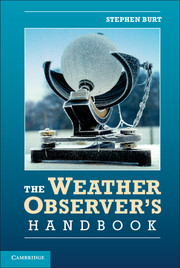Book contents
- Frontmatter
- Contents
- Acknowledgements
- Abbreviations, footnotes and references
- Part One The basics
- Part Two Measuring the weather
- 5 Measuring the temperature of the air
- 6 Measuring precipitation
- 7 Measuring atmospheric pressure
- 8 Measuring humidity
- 9 Measuring wind speed and direction
- 10 Measuring grass and earth temperatures
- 11 Measuring sunshine and solar radiation
- 12 Observing hours and time standards
- 13 Dataloggers and AWS software
- 14 Non-instrumental weather observing
- 15 Calibration
- 16 Metadata – what is it, and why is it important?
- Part Three Making the most of your observations
- Appendix 1 Metrology and meteorology: The basics of instrument theory
- Appendix 2 Useful functions
- Appendix 3 Unit conversions
- Appendix 4 Useful sources
- Index
- References
- Frontmatter
- Contents
- Acknowledgements
- Abbreviations, footnotes and references
- Part One The basics
- Part Two Measuring the weather
- 5 Measuring the temperature of the air
- 6 Measuring precipitation
- 7 Measuring atmospheric pressure
- 8 Measuring humidity
- 9 Measuring wind speed and direction
- 10 Measuring grass and earth temperatures
- 11 Measuring sunshine and solar radiation
- 12 Observing hours and time standards
- 13 Dataloggers and AWS software
- 14 Non-instrumental weather observing
- 15 Calibration
- 16 Metadata – what is it, and why is it important?
- Part Three Making the most of your observations
- Appendix 1 Metrology and meteorology: The basics of instrument theory
- Appendix 2 Useful functions
- Appendix 3 Unit conversions
- Appendix 4 Useful sources
- Index
- References
Summary
This chapter describes the various methods for measuring humidity, defines what the various humidity terms mean, and explains how they are related to each other. It describes the instruments and sensors used to measure atmospheric water vapour concentrations, and outlines the advantages and disadvantages of each. World Meteorological Organization guidelines on humidity instruments, siting and standard measurement techniques [1] are also included.
What is being measured?
The term ‘humidity’ refers to the amount of water vapour in the air. The fascinating physics of water vapour is one of the main components of the atmospheric heat engine which produces our weather. As a result, humidity measurements are an essential requirement for operational meteorological analysis and forecasting, for climate studies, hydrology, agriculture and many other areas of human activity and comfort. In the meteorological context, the terms relative humidity (RH) and dew point (Td) are most often used in specifying atmospheric water vapour content, but other terms are also used.
Humidity terminology
Under normal atmospheric conditions, the amount of water vapour any sample of air can hold depends mainly upon its temperature – warm air can hold much more water vapour than cold air. There are various terms used for expressing the amount of water vapour in the air – each can be converted to any of the others (see the example below), so knowing any one together with the air temperature (the ‘dry bulb’) enables the others to be found.
- Type
- Chapter
- Information
- The Weather Observer's Handbook , pp. 183 - 191Publisher: Cambridge University PressPrint publication year: 2012



